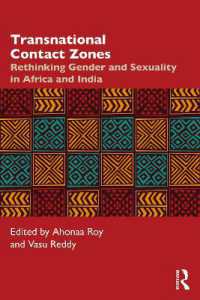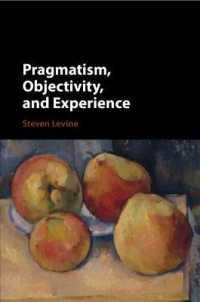- ホーム
- > 洋書
- > 英文書
- > History / World
Full Description
The War at Home interprets the experience of the Australian people during the Great War in Australia itself, in the politics of war, its economic and social effects, and in the experience of war; what is conventionally called social history. It seeks to show that the war affected many aspects of Australians livesand that peoples experience of 191418 included more than just the war. It also addresses the impact of the war on Australias culture and artistic
responses to the war.
This volume draws on the uneven but still substantial body of scholarship that has grown up in the decades since Ernest Scotts official history appeared in 1936, which in turn has largely been founded on an array of sources mainly made available since then. The Bibliographic Essay discusses the secondary literature on which it is based. It also reflects the experience of the years since then. The events of our past change how we understand more distant history. It is impossible now to think of
the internment of German Australians without also reflecting on the experiences of those detained in immigration detention camps, to think of the battle of Broken Hill without also thinking of the war on terror pursued from 2001, or to look at Norman Lindsays posters without recalling the insidious
influence of propaganda in the century since.
Before understanding the way the Great War affected Australians, we need to acknowledge the texture of life in 1914. Australia before the Great War was, as Michelle Hetherington writes in a survey of the last full year of peace, a world of glorious possibilities, in which as a social laboratory of progressive social, industrial and economic legislation it was eager to learn, to develop, to dream. The war would damage that dream, arguably fatally.
Contents
Series ForewordIllustrationsPrefacePart I Economy Peter Yule1. The Australian Economy in 19142. The Economic Impact of War, 19143. Supplying the War 4. Trading with the Enemy 5. Wheat and Wool6. The Little Salesman 7. Manufacturing 8. Financing the War 9. Striking: Industrial Relations During the War 10. The Economic Impact of War, 1919Part II Politics John Connor11. The Outbreak of War and the 1914 Election12. Labor Ascendant, 191513. Hughes in Europe and the Conscription Debate, 1916 14. Conscription Referendum and the Labor Split, 1916 15. Formation of the Nationalist Party and the Federal Election, 1917 16. Conscription Referendum, 1917 17. Politics in 1918 18. Politics in 1919Part III Society Peter Stanley 19. Cheering: Outbreak, Shots and Loyalty 20. Accepting: Casualties, Regulations, Internment 21. Mobilising: Volunteers and Censorship 22. Supporting: Women, Children and Men 23. Jeering: Pacifists, Sport and Ordinary Life 24. Understanding: Faith, Propaganda and Culture 25. Enduring; Sacrifice, Aborigines and Sex 26. Suffering: Grief, Sectarianism and War Weariness 27. Returning: Armistice, Repatriation and Reconstruction 28. Remembering: Anzac, Scott's History and War's Effects Bibliographic Essay Notes








